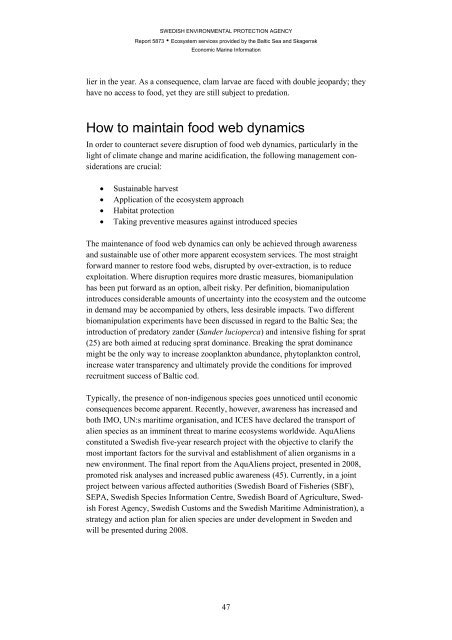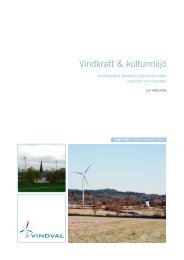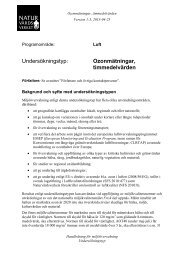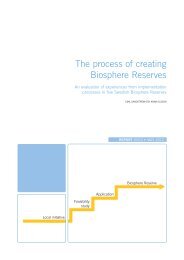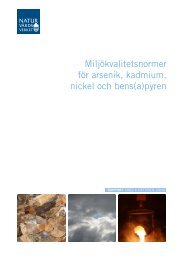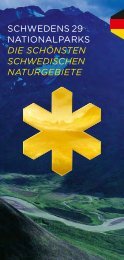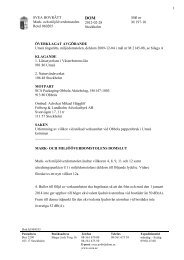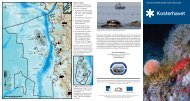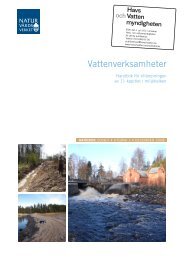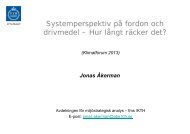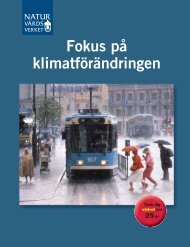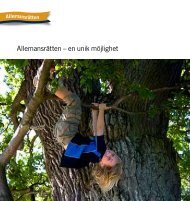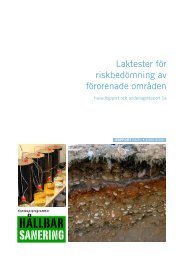Ecosystem services provided by the Baltic Sea ... - Naturvårdsverket
Ecosystem services provided by the Baltic Sea ... - Naturvårdsverket
Ecosystem services provided by the Baltic Sea ... - Naturvårdsverket
You also want an ePaper? Increase the reach of your titles
YUMPU automatically turns print PDFs into web optimized ePapers that Google loves.
SWEDISH ENVIRONMENTAL PROTECTION AGENCY<br />
Report 5873 • <strong>Ecosystem</strong> <strong>services</strong> <strong>provided</strong> <strong>by</strong> <strong>the</strong> <strong>Baltic</strong> <strong>Sea</strong> and Skagerrak<br />
Economic Marine Information<br />
lier in <strong>the</strong> year. As a consequence, clam larvae are faced with double jeopardy; <strong>the</strong>y<br />
have no access to food, yet <strong>the</strong>y are still subject to predation.<br />
How to maintain food web dynamics<br />
In order to counteract severe disruption of food web dynamics, particularly in <strong>the</strong><br />
light of climate change and marine acidification, <strong>the</strong> following management considerations<br />
are crucial:<br />
<br />
<br />
<br />
<br />
Sustainable harvest<br />
Application of <strong>the</strong> ecosystem approach<br />
Habitat protection<br />
Taking preventive measures against introduced species<br />
The maintenance of food web dynamics can only be achieved through awareness<br />
and sustainable use of o<strong>the</strong>r more apparent ecosystem <strong>services</strong>. The most straight<br />
forward manner to restore food webs, disrupted <strong>by</strong> over-extraction, is to reduce<br />
exploitation. Where disruption requires more drastic measures, biomanipulation<br />
has been put forward as an option, albeit risky. Per definition, biomanipulation<br />
introduces considerable amounts of uncertainty into <strong>the</strong> ecosystem and <strong>the</strong> outcome<br />
in demand may be accompanied <strong>by</strong> o<strong>the</strong>rs, less desirable impacts. Two different<br />
biomanipulation experiments have been discussed in regard to <strong>the</strong> <strong>Baltic</strong> <strong>Sea</strong>; <strong>the</strong><br />
introduction of predatory zander (Sander lucioperca) and intensive fishing for sprat<br />
(25) are both aimed at reducing sprat dominance. Breaking <strong>the</strong> sprat dominance<br />
might be <strong>the</strong> only way to increase zooplankton abundance, phytoplankton control,<br />
increase water transparency and ultimately provide <strong>the</strong> conditions for improved<br />
recruitment success of <strong>Baltic</strong> cod.<br />
Typically, <strong>the</strong> presence of non-indigenous species goes unnoticed until economic<br />
consequences become apparent. Recently, however, awareness has increased and<br />
both IMO, UN:s maritime organisation, and ICES have declared <strong>the</strong> transport of<br />
alien species as an imminent threat to marine ecosystems worldwide. AquAliens<br />
constituted a Swedish five-year research project with <strong>the</strong> objective to clarify <strong>the</strong><br />
most important factors for <strong>the</strong> survival and establishment of alien organisms in a<br />
new environment. The final report from <strong>the</strong> AquAliens project, presented in 2008,<br />
promoted risk analyses and increased public awareness (45). Currently, in a joint<br />
project between various affected authorities (Swedish Board of Fisheries (SBF),<br />
SEPA, Swedish Species Information Centre, Swedish Board of Agriculture, Swedish<br />
Forest Agency, Swedish Customs and <strong>the</strong> Swedish Maritime Administration), a<br />
strategy and action plan for alien species are under development in Sweden and<br />
will be presented during 2008.<br />
47


